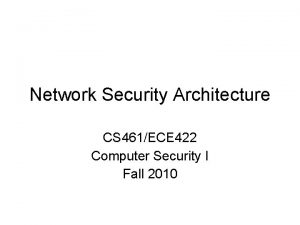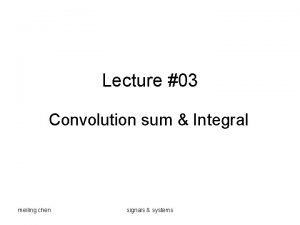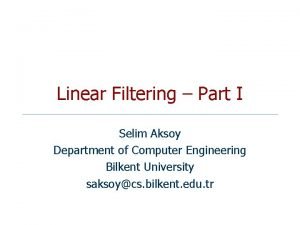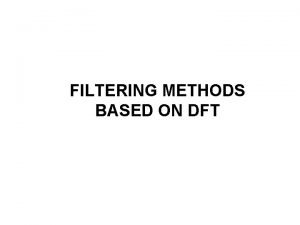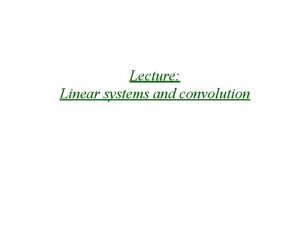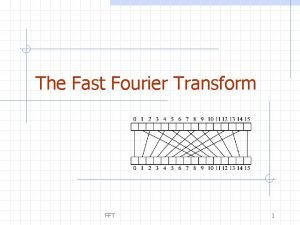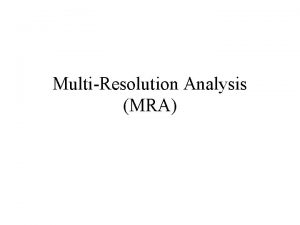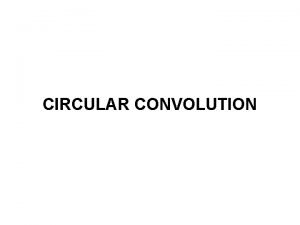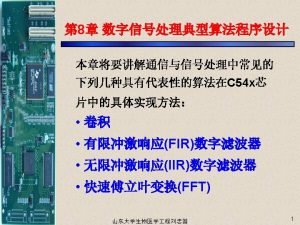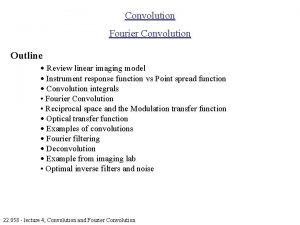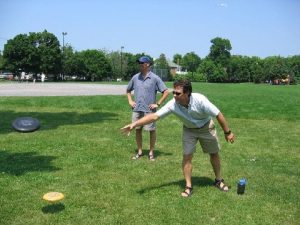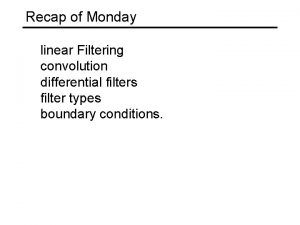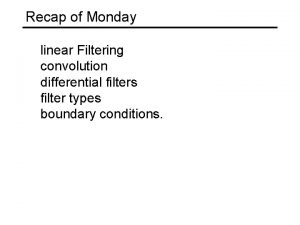USE OF FFT IN LINEARING FILTERING Linear Convolution




![For example, consider two sequences h[n] and x[n] as follows. For example, consider two sequences h[n] and x[n] as follows.](https://slidetodoc.com/presentation_image_h2/af4b3455d3a01b513013723cc1e29086/image-5.jpg)
![Segmenting x[n] into Llength sequences. Each segment is padded by P 1 zero values. Segmenting x[n] into Llength sequences. Each segment is padded by P 1 zero values.](https://slidetodoc.com/presentation_image_h2/af4b3455d3a01b513013723cc1e29086/image-6.jpg)

![Example of overlapping-save method Decompose x[n] into overlapping sections of length L Example of overlapping-save method Decompose x[n] into overlapping sections of length L](https://slidetodoc.com/presentation_image_h2/af4b3455d3a01b513013723cc1e29086/image-8.jpg)
![Example of overlapping-save method (continue) Result of circularly convolving each section with h[n]. The Example of overlapping-save method (continue) Result of circularly convolving each section with h[n]. The](https://slidetodoc.com/presentation_image_h2/af4b3455d3a01b513013723cc1e29086/image-9.jpg)
- Slides: 9

USE OF FFT IN LINEARING FILTERING

Linear Convolution Using DFT Ø Recall that linear convolution is when the lengths of x 1[n] and x 2[n] are L and P, respectively the length of x 3[n] is L+P-1. Ø Thus a useful property is that the circular convolution of two finite-length sequences (with lengths being L and P respectively) is equivalent to linear convolution of the two N-point (N L+P 1) sequences obtained by zero padding. Ø Another useful property is that we can perform circular convolution and see how many points remain the same as those of linear convolution. When P < L and an L-point circular convolution is performed, the first (P 1) points are corrupted by circulation, and the remaining points from n=p 1 to n=L 1 (ie. The last L P+1 points) are not corrupted (ie. , the last L P+1 points remain the same as the linear convolution result).

Block convolution (for implementing an FIR filter) Ø FIR filtering is equal to the linear convolution of a (possibly) infinite-length sequence. Ø To avoid delay in processing, and also to make efficient computation, we would like to segment the signal into sections of length L. Each L-length sequence can then be convolved with the finite-length impulse response and the filtered sections fitted together in an appropriate way. – called block convolution. Ø When each section is sufficiently large, we usually use circular convolution (instead of linear convolution) to compute each section. (since it will be shown that there are fast algorithms, fast Fourier transform (FFT), to compute circular convolutions highly efficiently) Ø Two methods for circular-convolution-based block convolution: Overlapping-add method and overlapping-save method.

Overlapping-add method (for implementing an FIR filter) When segmenting into L-length segments, the signal x[n] can be represented as where Because convolution is an LTI operation, it follows that where Since xr[n] is of length L and h[n] is of length P, each y r[n] has length (L+P 1). So, we can use zero-padding to form two N point sequences, N=L+P 1, for both xr[n] and h[n]. Performing N-point circular convolution (instead of linear convolution) to compute y r[n].
![For example consider two sequences hn and xn as follows For example, consider two sequences h[n] and x[n] as follows.](https://slidetodoc.com/presentation_image_h2/af4b3455d3a01b513013723cc1e29086/image-5.jpg)
For example, consider two sequences h[n] and x[n] as follows.
![Segmenting xn into Llength sequences Each segment is padded by P 1 zero values Segmenting x[n] into Llength sequences. Each segment is padded by P 1 zero values.](https://slidetodoc.com/presentation_image_h2/af4b3455d3a01b513013723cc1e29086/image-6.jpg)
Segmenting x[n] into Llength sequences. Each segment is padded by P 1 zero values. Fir filtering by using the overlapping-add method.

Overlapping-save method (for implementing an FIR filter) Can we perform L-point circular convolution, instead of (L+P 1)point circular convolution? If a P-point sequence is circularly convolved with a P-point sequence (P<L), the first (P 1) points of the result are incorrect, while the remaining points are identical to those that would be obtained by linear convolution. Ø Separating x[n] as overlapping sections of length L, so that each section overlaps the preceding section by (P 1) points. Then
![Example of overlappingsave method Decompose xn into overlapping sections of length L Example of overlapping-save method Decompose x[n] into overlapping sections of length L](https://slidetodoc.com/presentation_image_h2/af4b3455d3a01b513013723cc1e29086/image-8.jpg)
Example of overlapping-save method Decompose x[n] into overlapping sections of length L
![Example of overlappingsave method continue Result of circularly convolving each section with hn The Example of overlapping-save method (continue) Result of circularly convolving each section with h[n]. The](https://slidetodoc.com/presentation_image_h2/af4b3455d3a01b513013723cc1e29086/image-9.jpg)
Example of overlapping-save method (continue) Result of circularly convolving each section with h[n]. The portions of each filter section to be discarded in forming the linear convolution are indicated
